
Rocky 2022 R1:
Going beyond the traditional Discrete Element Method, this new release includes multiple new capabilities to improve the simulation of industrial processes for discrete solid mechanics. This release maintains a high level of accuracy while focusing on three key areas:

Usability
A Material Wizard offers reliable and fast material calibration.

Performance
A Multi-zone Dynamic Domain optimizes computations for applications with a large particle count, and an innovative Particle Assembly methodology speeds up modeling of complex particle shapes.

Expansion
Simulation of particle-laden flows is extended to other physics, first by beta release of a new embedded smoothed-particle hydrodynamic SPH-DEM solver for free surface flows, and second by expanding existing CFD-DEM solutions to account for complex heat, mass transfer, and chemical reaction.
March 21, 2022 – ESSS announces the release of its top-tier particle dynamics modeling software Rocky 2022R1. This release enables faster, easier, and accurate particle dynamics simulations with larger numbers of particles while offering tighter integration with other physics. Engineers will have access to a science-based, easy-to-use material calibration platform, plus the ability to accelerate simulation as much as 10x by using a Multi-zone Dynamic Domain. Particle-laden free surface flows can be simulated using a new multi-CPU and a multi-GPU SPH-DEM coupled solver.
“The release of Rocky 2022R1 is another installment of delivering our vision to solve all types of engineering problems involving discrete solids, with the solution timeframe, capabilities and usability required by engineers”, said Clovis Maliska Jr, ESSS CEO.
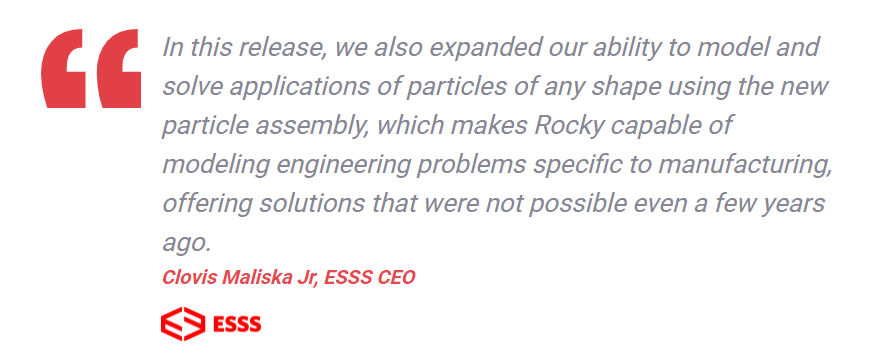
The 2022R1 Material Wizard dovetails into Rocky’s calibration suite and is designed to jump-start Rocky simulations by turning real-world material information into ready-to-use setup parameters. The Wizard compares experimental data with a built-in material database and uses AI/ML techniques to provide the best required material-related simulation parameters. The Wizard is fully customizable and configurable to individual applications or groups of materials and can be downloaded directly from Rocky’s customer portal. Watch the video below for more information or read our blog for a more detailed overview of the Wizard’s capabilities.
The Multi-zone Dynamic Domain enables faster simulation, making it possible to simulate applications with several millions of particles by both reducing memory requirements and speeding computational time. This simulation optimization methodology enables dynamic calculation zones of interest to include or minimize contact detection inside or outside of the zones, based on where the particles are active. For example, the simulation of disk harrow equipment (shown below) was accelerated by 9x using the new dynamic simulation domain capability.
Sample Rocky simulation using multi-zone dynamic domain – Disk Harrow
In response to a growing demand to model complex particle shapes in applications beyond traditional DEM, especially in manufacturing, the current Rocky release enables assembling of different particles to form new shapes. The Particle Assembly model improves computational performance for complex concave shape particles and enables simulation of limitless discrete particle shapes.
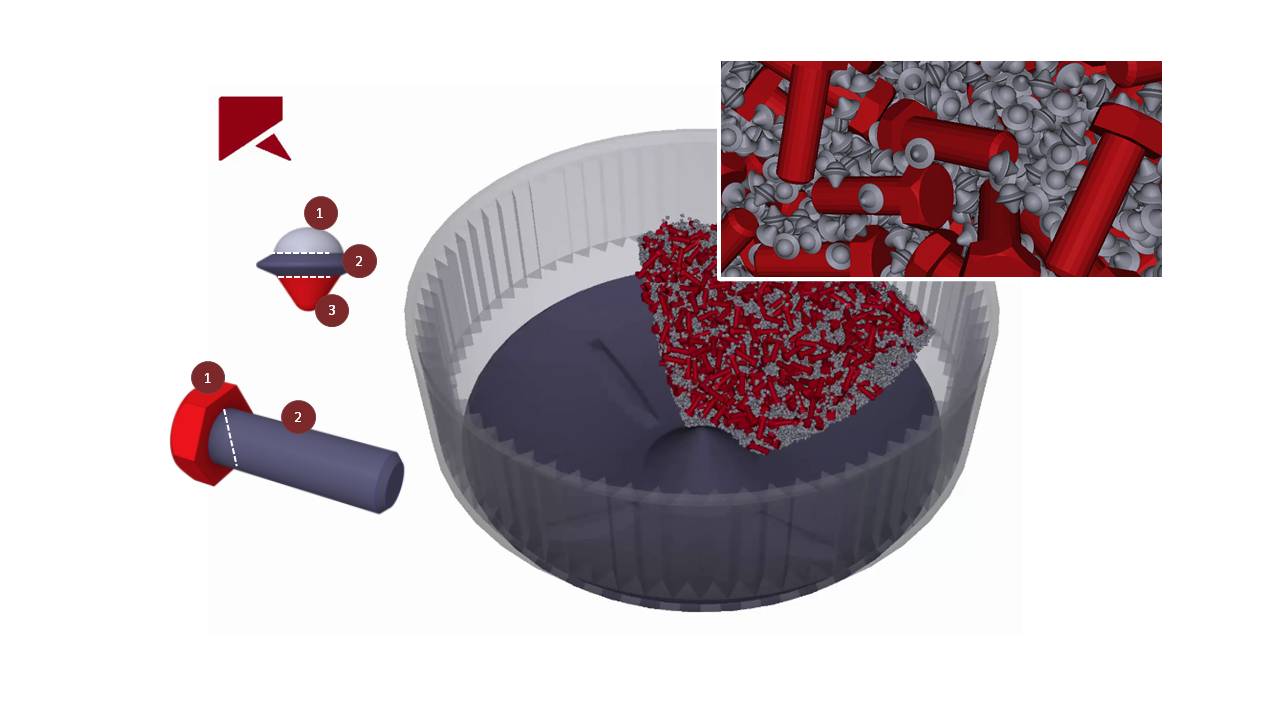
Polishing/Finishing Process: Simulation of bolt finishing equipment using the Particle Assembly model runs 36x faster with 22x less memory.
Another relevant capability in the 2022R1 release is the introduction of a bond model that extends Rocky’s advantage in modeling particle breakage. This new model simulates the behavior of material represented as a collection of bonded particles of any shape. In cases where the material can be characterized, the model predicts the material response to an applied dynamic force.
Tool-part modeling of a drilling application using particle-bond model. The bonded material can be particles of any shape and can break due to tensile or shear stresses.
Rocky is launching the beta version of its native SPH-DEM solver kernel with a focus on particle-laden free surface flows. The solver is developed native to multi-GPUs and multi-CPUs. The SPH-DEM coupling offers an effective simulation approach for slurry flows, for example. The solution methodology efficiently accounts for the presence of different sized and shaped particles as well as fluid-particle interaction.
Sample snapshot of a simulation of iron ores in a ball mill. Rocky’s embedded SPH (Beta) and DEM coupled solver is used to model the slurry pooling phenomena.
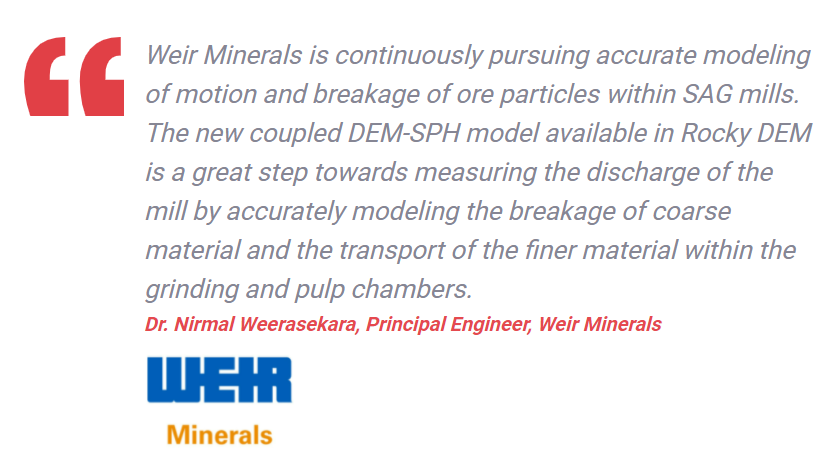
The 2022R1 release extends Rocky’s applications of Ansys CFD coupling that involve particle size changes due to mass and heat transfer (conduction, convection, and radiation) with or without chemical reactions. The effect of particle size changes can be used in particle drying, particle gasification, and pyrolysis. For transient calculations, CFD and DEM are coupled in multiple ways, including the new 1-Way transient developed to accelerate simulation with moving geometries, such as pumps and stirred tanks.
The 2022R1 is a robust release and includes a host of new and improved capabilities. Rocky is a new platform for modeling discrete solid mechanics beyond traditional DEM applications. To learn more, we invite you to join ESSS’ Rocky 2022R1 launch event on April 6th by registering at the link below.

Rocky DEM 4.5: performance and expanded integration with Ansys software
Rocky DEM 4.5 simulation software is accelerating engineers’ use of particle modeling through improved computational speed, solver flexibility, and deeper integration with Ansys.


Fast solutions
Rocky 4.5 offers impressive speed across the board when compared to previous releases, with as much as 10x gains in calculation time.

Extended and deeper integration
Rocky 4.5 deepens integration with Ansys simulation software. Additional and new capabilities are available in four major areas: Multibody Dynamic (Ansys Motion), CFD-DEM (Ansys Fluent), Design Exploration (Ansys optiSLang), Simulation Data Management (Ansys Minerva).

Expanded Solver API
Over 30 new, ready-to-use modules have been added to the existing API library.
ESSS announces the newest release of its powerful Discrete Element Modeling software – Rocky DEM 4.5. This release delivers significant advances in solving particle dynamics engineering problems, enabling much faster solution of applications with large numbers of particles. Rocky DEM 4.5 also expands the innovation possibilities of particle-laden systems through expanded integration with Ansys simulation software, further supporting customers’ digital engineering strategies.
Rocky coupling with Ansys Motion creates the possibilities to simulate complex machine-particle interactions across multiple industries.
Release highlights include:
Increased ability to simulate free and rigid body motion through coupling with Ansys Motion multi-body dynamic software, helping engineers account for flexible components, kinematic forces, and link chains. Together with Ansys Motion, Rocky 4.5 performs analyses that consider the stress and deformation of flexible body components.
Simulation of motion and stresses of a backhoe – including flexible bodies and bushing fixtures using Rocky and Ansys Motion.
Expanded CFD-DEM capability now includes a broader range of particle-fluid applications, plus solutions for flows where particles are much larger than CFD mesh, all in a well-integrated workflow with Ansys Fluent.
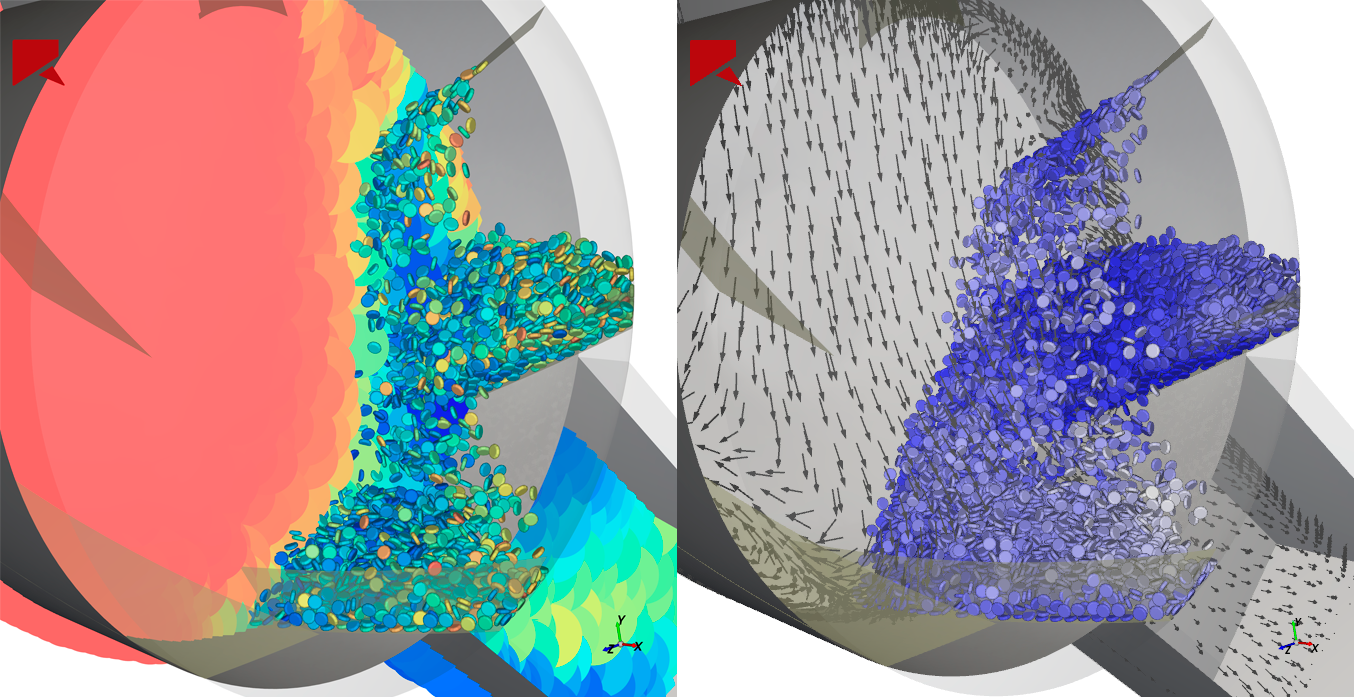
Sample snapshots of enhanced Rocky Ansys Fluent post-processing from a particle drying simulation – Fluid and particle temperature (left), Fluid flow velocity and particle drying rate (right)
- Seamless integration with Ansys optiSLang supports model calibration and enables large-scale design exploration for design optimization and verification. In addition, Rocky users can now generate reduced order models (ROMs) for their process simulations to implement digital twins in Ansys Twin Builder and on a variety of software and hardware platforms.
- Integration with Ansys Minerva for efficient simulation processes and data management.
- Multi-CPU and multi-GPU improved performance and scalability for all applications. Performance tests for this new release showed impressive advancement across the board when compared to previous releases, with gains ranging from 50% to 1000%, depending on the application type.
- Expanded solver API and GUI customization support, with an additional 30+ ready-to-use specialized physical modules. Rocky 4.5 expands the existing API library template available for customers to download. With additional exposure, users can do even more with Rocky, like working on their own breakage models and custom CFD coupling laws.
Maliska added, “Our focus has always been to solve particle dynamics problems in timelines that are acceptable to engineers, while delivering top performance on accuracy, capabilities, and deeper integration into our customers’ simulation workflow using the Ansys software platform.”
One example of this performance improvement is the coupling with Ansys Motion.

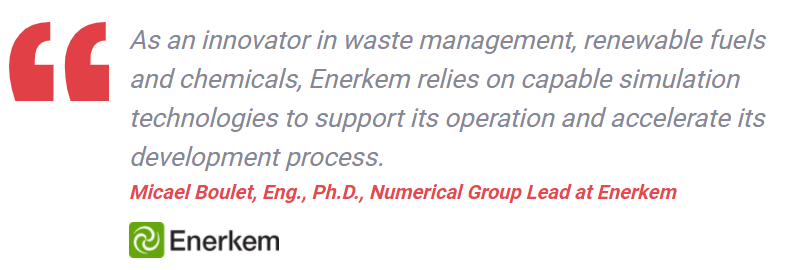
“The Combination of Rocky and Ansys Fluent has given us access to an accurate and powerful simulation tool, and with release 4.5 we are looking to solve large, and complex coupled problems faster, while we take advantage of new physical models and modeling capabilities of Rocky 4.5.” added Mr. Boulet.
The Rocky 4.5 integration with Ansys Minerva enables users to better manage their particle simulation data and easily collaborate by sharing project information between stakeholders.
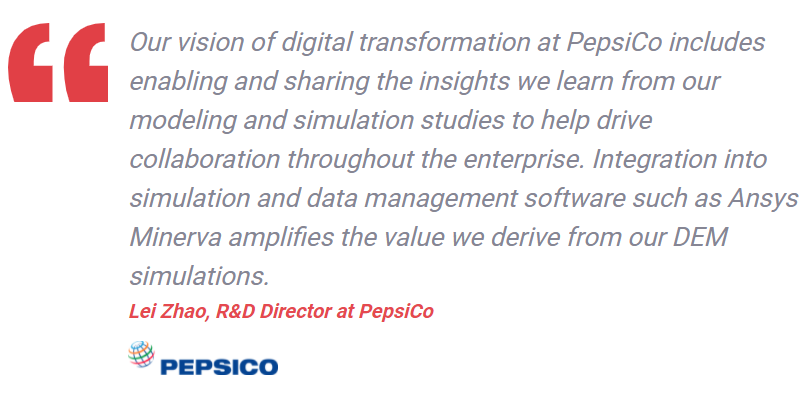
For more information, please join our Rocky DEM 4.5 launching event below, or contact us.
Rocky DEM release 4.4: reinventing solver customisation
Rocky DEM 4.4 delivers a totally new Solver Application Programming Interface (Solver API) based on the most-recent technology for customization and user experience integration. The result delivers unique usability, portability and, above all, solver performance.
What’s different in Rocky DEM 4.4’s Solver API?
User experience
All models implemented with the Solver API also modify and extend the setup and post-processing software interface. In the setup stage, to enter custom model input parameters, the software dynamically generates a visual interface; in the post-processing stage, all new custom variables are automatically available for detailed analysis. This enables seamless deployment of custom models built by experts, all across the corporation.
A single code for both multi-CPU & multi-GPU solvers
The Solver API provides a unified approach so users can program models by enabling just one single code to be compatible with both Rocky DEM solver technologies. This substantially reduces the cost involved in maintaining custom routines or learning complex GPU programming techniques.
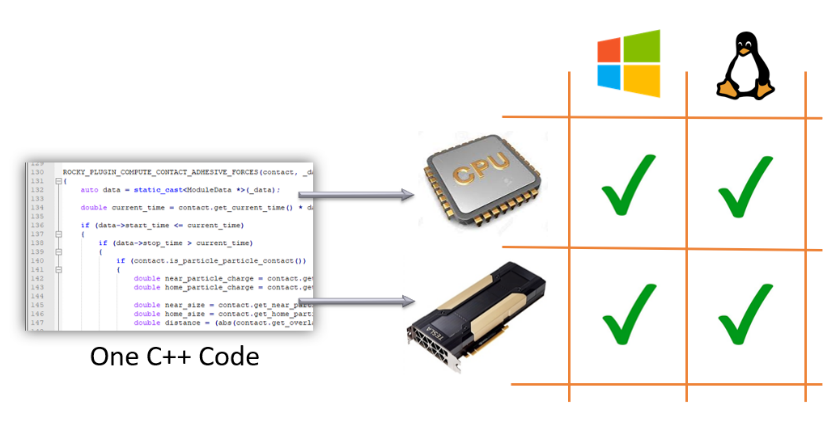
No performance degradation
Custom models implemented using the Solver API run as fast as original embedded models. Rocky DEM provides a true application programming interface, and not just a “set of function hooks”. Users can implement their own models using the same structure and logics from embedded models, all without code virtualization or memory overhead.
“We wanted to deliver something innovative. We did not want our users to experience poor performance or miss out on any features. And worst-case, we did not want our customers to have to rewrite their code because they were now using the multi-GPU solver.” Marcos Cabral Damiani, Platform Development Manager at ESSS
The new Solver API in Rocky DEM 4.4 is C++ based, and it enables many new physics to be implemented — such as new contact and joint models, particle properties, body forces, and custom scalars.
“In the tablet coating process, tablet mixing, spraying and drying happen simultaneously and impact the final product quality. The Rocky DEM smart API provides capability to couple air flow, the heating and drying model, and tablet motion to capture the complex physics in the coater.” – Gopal Kasat, Project Manager from Tridiagonal Solutions
Other Rocky DEM 4.4 new functionalities include a custom particle input, the ability to freeze elements, and a user definition of center of mass and moment of inertia, with a focus on solid particles with complex shapes and high aspect ratios. Also, a new cylindrical periodic boundary condition is included as well as several other improvements.
By adding our new C++ Solver API together with the existing Python-based API for workflow automation, Rocky DEM 4.4 redefines what API means by delivering best-in-class functionality to customers who need flexibility without compromising performance.




